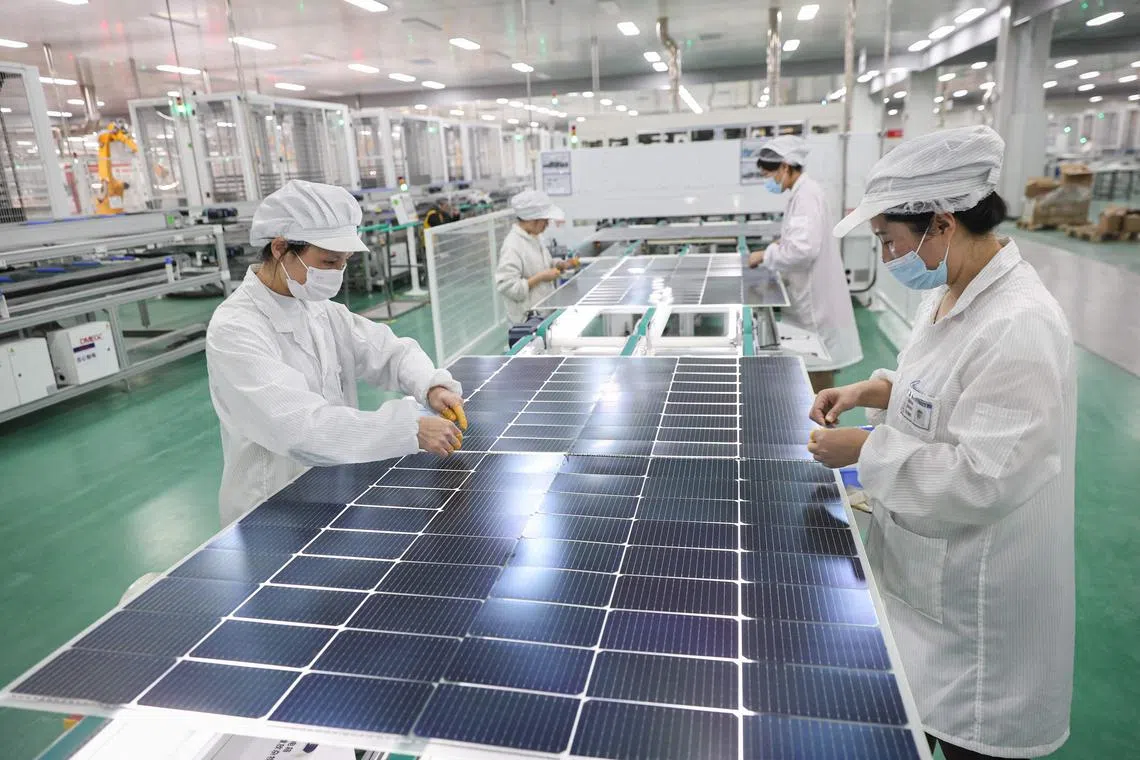South-east Asia solar boom at risk from US-China trade stress
Sign up now: Get ST's newsletters delivered to your inbox

Some production has been halted as the US looks set to impose hefty tariffs on the region.
PHOTO: AFP
Follow topic:
SINGAPORE – The future of South-east Asia’s booming solar industry, which produces the most panels in the world after China, is being thrown into doubt as the US looks set to impose hefty tariffs on the region.
Chinese firms that set up factories in the region over the last decade are now being accused of skirting US import levies on their home market. At least three – including Longi Green Energy Technology and Trina Solar – have scaled back operations in Thailand, Vietnam and Malaysia, which, along with Cambodia, are being targeted by Washington.
The four countries account for more than 40 per cent of solar module production capacity outside of China, according to BloombergNEF (BNEF), and other Chinese firms with facilities there are hunting for markets to replace the US.
“The mood of the suppliers is to pack the lines, especially the cell lines, and move them to either Indonesia, Laos or the Middle East,” said Ms Yana Hryshko, the head of global solar supply chain research at Wood Mackenzie. Some Chinese manufacturers are waiting to see what the tariff level will be before deciding if they need to relocate, she said.
The uncertainty underscores broader turbulence in clean energy supply chains as the US, Europe and others seek to claw back some market share from China, which dominates the production of solar equipment as well as electric vehicle batteries. The Chinese solar firms are also struggling with a worsening domestic glut that has already seen a number of smaller players go under.
A US investigation in August 2023 concluded that some Chinese manufacturers – which initially started investing in South-east Asia after the US imposed tariffs on panels imported directly from China in 2012 – were illegally bypassing those levies. The ruling led to import taxes of varying levels being imposed on five companies in the region.
Some US firms are now asking Washington for further tariffs of as high as 272 per cent on all solar products from the four countries, although BNEF said in May that they would likely be between 30 per cent and 50 per cent. That compares with levies of 25 per cent on China, which the White House is planning to double.
Washington moved closer to instituting the tariffs in June, with the US International Trade Commission passing an initial vote determining manufacturers are being harmed by cheap imports from South-east Asia.
US solar panel imports from South-east Asia surged 36 per cent to a record in the last quarter as buyers raced to lock in supply before tariff waivers ended.
Since then, Chinese and Malaysian publications have reported that Longi halted five production lines in Vietnam and began winding down operations in Malaysia, Trina is planning to shut some capacity in the region, and Jinko Solar closed a plant in Malaysia.
A Longi spokesperson said in June that it had made adjustments to plans for output at several factories, in part because of the trade policy changes. The company said in a subsequent exchange filing that its factory in Malaysia is still shipping cells to the US, and it has no plan to move capacity as demand from other markets, including India and Canada, would be sufficient to support the South-east Asian plants.
Trina’s Thailand cell factory is still operating normally, and it will decide what to do with its South-east Asian facilities depending on the outcome of the latest round of the US probe, it said in a statement. Jinko did not respond to a request for comment, while JA Solar said its plant in Vietnam is operating normally.
Not all Chinese factories in South-east Asia will shut down, as products from there can be shipped to India, Europe and elsewhere, according to Mr Dennis Ip, an analyst at Daiwa Capital Markets. Some older facilities might be closed, but newer plants should be able to survive if they can find alternative markets, he said.
The stricter line from the US comes as both major political parties there take a tougher stance against Beijing in the run-up to the election in November. As well as imperilling South-east Asian production, it could jeopardise Washington’s decarbonisation efforts, given more than three-quarters of its solar product imports came from the region in 2023.
Efforts to limit the perceived circumvention of US restrictions on Chinese imports are likely to continue and this would be especially true if Donald Trump gets elected, said Dr Deborah Elms, head of trade policy at the Hinrich Foundation, an Asian-based non-profit organisation that works to advance sustainable global trade. Trump is “extremely focused” on countries that the US has trade deficits with, and these include many South-east Asian nations, she said. BLOOMBERG

